My co-author, Joyce Cheney, did a good job describing these events in our book, “The First 100 Years, Maplewood, MO.” Writing from her own research, she had this to say.
Attention K-Mart Shoppers
James O. Holton, president of Citizen’s National Bank in Maplewood decided to take redevelopment into his own hands. Holton gathered fifty-seven local businessmen at The St. Louis Club and presented his vision for redevelopment: a six-block stretch of Manchester Avenue and surrounding streets, from Oakview Terrace to Big Bend would be rebuilt with retail venues in a park-like setting. The anchor building would be a new Citizen’s Bank.
Holton told the group that business profits had actually been rising and that businesses that had packed up and left had done so for their own reasons, not because Maplewood was unprofitable. Holton vowed to restore the area to its former level of prestige.
Though the proposal was controversial from the start, the city approved the plan. Developers started buying targeted homes and businesses, and a few homes were demolished. Wreckers razed EJ Tire Company in the building once occupied by The Wedge to make way for a five-story, $1.1M building-two floors for parking and three for medical and professional offices.
Angry citizens launched a referendum and succeeded in halting the project. Then another group launched a petition drive to put the project up for a vote, and the plan was resurrected. Mayor Hammes announced to a capacity crowd at a City Council meeting that the plan was going forward- and that a J.C.Penney Department Store would anchor the development. The very next day headlines in The Post-Dispatch screamed that Penny’s was not coming to Maplewood. Holton’s funders backed out and buyouts and demolitions ceased. Holton’s development plan called “A Return to the Maple Leaf” was dead – for the second time.
Just months later the City of Maplewood and Holton made another announcement. They were resurrecting one segment of the previous several block plan and bringing in a K-Mart. … Citizens rallied in opposition to the plan and called their group “I CARE.” The group vehemently objected to invoking eminent domain to seize owner-occupied homes. In spite of I CARE opposition … Some residents lost their homes and became renters in the new surrounding apartments. … Maplewood faced economic drought in the 1960’s and 70’s from forces beyond Maplewood. … The modified development plan moved forward. But it cost Mayor Hammes his job: he was recalled and replaced by Henry Liessing. This new mayor was shortly recalled as well.
Maplewood voters had lost confidence in their government. A citizen’s group felt that Maplewood needed a new government structure, one in which the mayor wielded less power. Though the town’s three commissioners were elected, in practice they ran as a slate and came to power on the mayor’s coattails. In 1976, Maplewood’s current charter form of government was put into place. Today Maplewood has a mayor and six councilman (men and women), all elected. Mayor and councilmen all have one vote on issues that city staff and citizens bring for Council consideration. The city manager and staff carry out city plans and policies and run day-to-day Maplewood.
Joyce Cheney 2008 from The First 100 Years, Maplewood, MO pgs. 80-83.
Good job, Joyce! Joyce included more detail than I have room for here. Our book can be found at the Maplewood Public Library or purchased at the office of the MCBF (pronounced Mac Beef. Maplewood Community Betterment Foundation) at 2915 Sutton Ave in our fair city.
On the same subject, I just reloaded the photographs for these two earlier posts.
What the Heck Happened to the North Side of our Business District? and
What the Heck Happened to the North Side of our Business District? Part 2
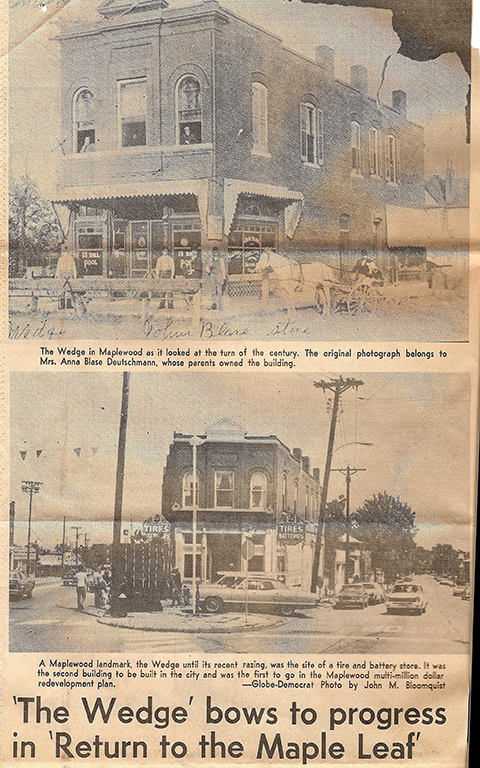
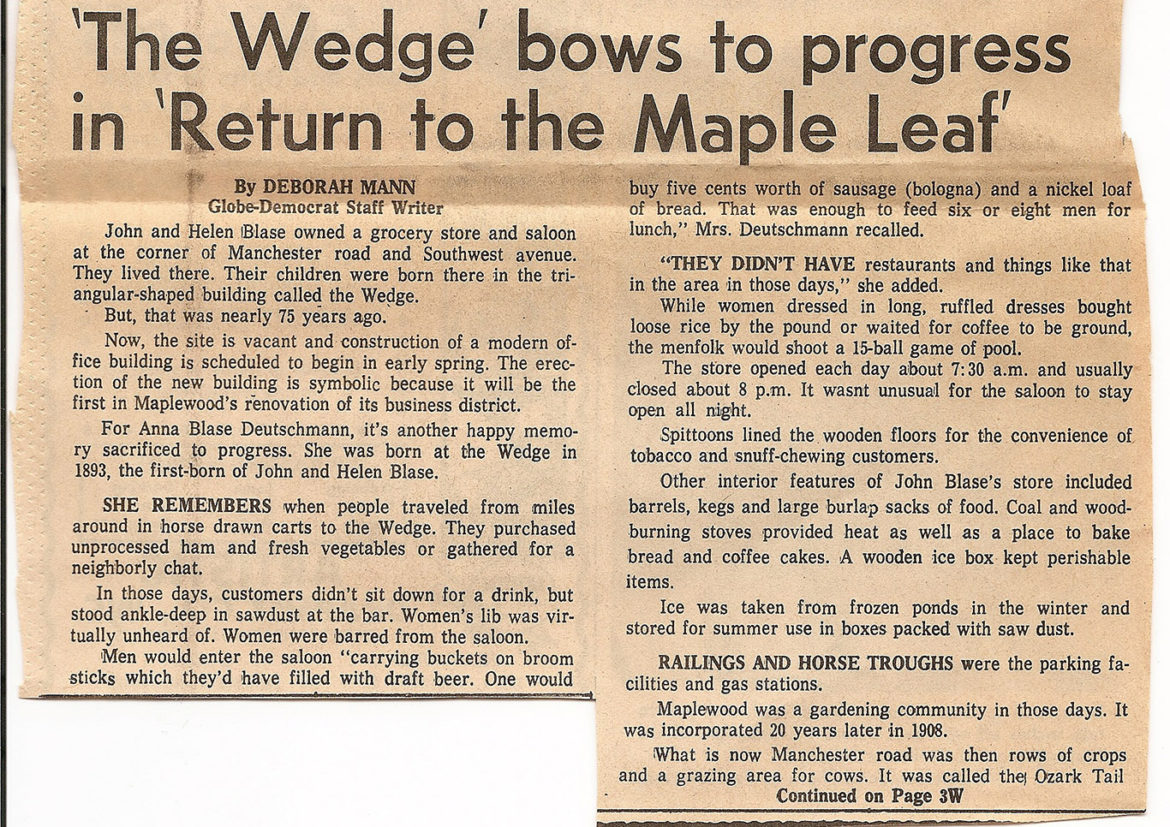
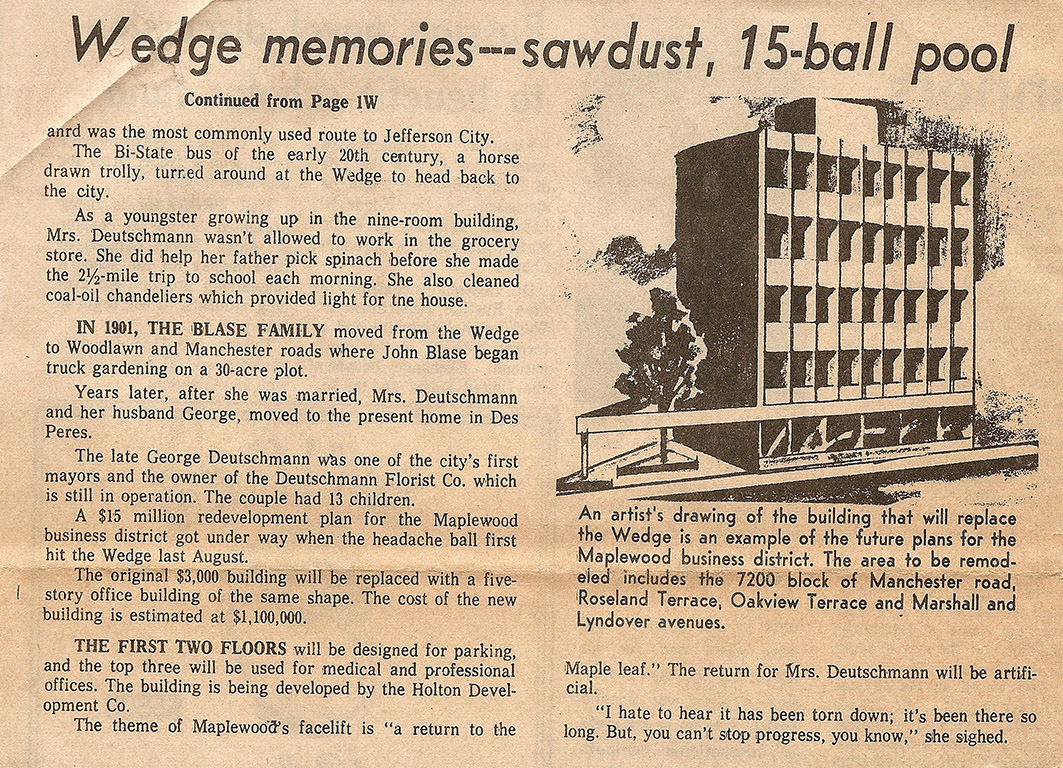
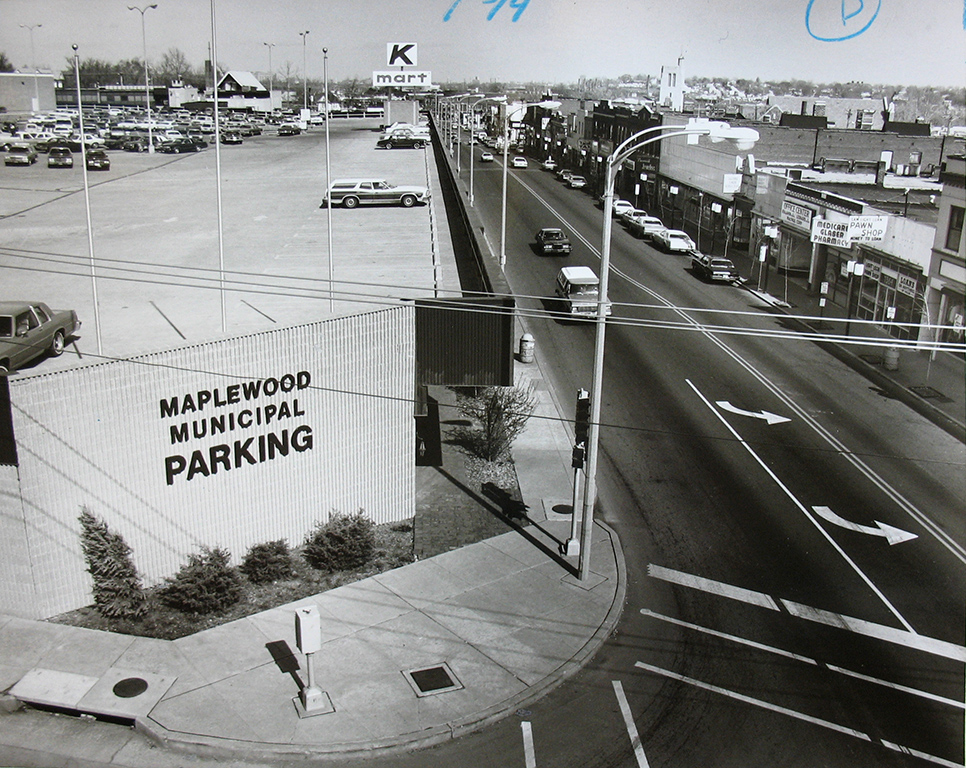

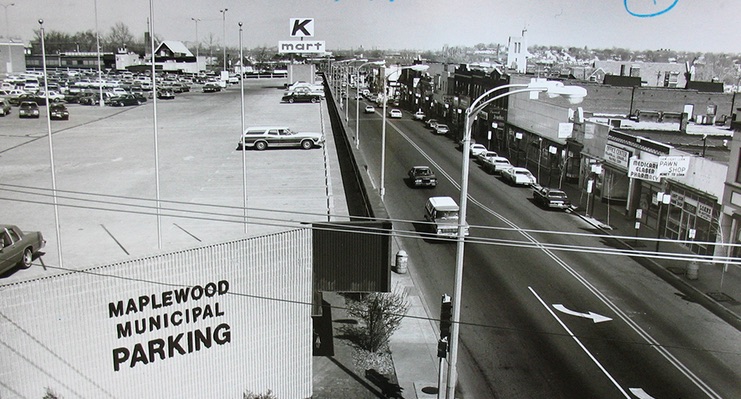
Those two “What the Heck” articles are really important, Doug, as cautionary tales for “developers” who want to tear down too much too fast to reach for the short money. The photos — particularly the two representing the row of commercial storefronts along the north side of Manchester, one shot from the east, one from the west — are heartbreaking.
Great work, as usual. Glad you’re still on the case.
Thank you for the compliments, Yojimbo. Those photos are heartbreaking. In this day and age wouldn’t you think that with all of the architecture we have lost in the past, we would all be more careful about what we decide to part with? When it’s gone, it’s gone. Case in point – the Harper Pharmacy cabinetry. Man, I can’t believe we had no way to protect those from the incredibly bad decision to remove them made by the leaders of the current tenants of that space, the Sierra Club. THE SIERRA CLUB! If there was ever a tenant that would have protected that historic interior, it should have been them.
Friday night’s and Saturdays in Maplewood were busy times in the 50s and 60s. Streets were full of shoppers. I remember Blusteins clothing, Woolworths, Kresges department store in Maplewood. Was a busy little place then.
It definitely was, Tom. With all the activity on the south side of Manchester now it’s too bad we no longer have those shops on the north side. If we did I think we’d be seeing the kind of use we once had again. Thank you for your comment.
Oh wow, this brings back memories. I clearly remember that “Maplewood Municipal Parking” sign. Almost doesn’t seem like its ben that long since the K Mart complex was torn down but that must have been (maybe) in the mid-late 1990s.
I don’t remember the exact dates either, Todd. I was still working in those days. It’s odd how something that major can be happening so close and how little one might know of it due to the distractions of work and family. I appreciate your comment.
According to St Louis County’s website, the Shop N Save building was constructed in 1998. I thought it was older than that but I was living out of the area at that time.
It was def 1998. My wife and I moved to Maplewood in Spring of ’98. We shopped at the old SNS one time before it closed. I recall there were inventory sales going on……being a young couple on a tight budget rehabbing a 1904 home, we took advantage of that! Not sure why I recall this, but we bought Mac n’ Cheese on sale, 8 boxes for 88 cents. LOL…..I think we bought 32 boxes. Now we go to that same building, and pay more for one Kolsch than we did for 32 boxes of Mac n Cheese……and happy to do so.
The ‘nabe has come a long, long way, and we have enjoyed the transformation and raising our family here.
You got that right about the Kolsch. Fortunately we can still buy a quart can of Miller at S-n-S for 99 cents.
The loss of Goldie’s department store following the fire greatly accelerated the demise of the7200 – 7400 blocks of the business district. The beginning of the renaissance I believe was two anchor stores: Bobby’s Cajun, a very upscale restaurant at Sutton and Manchester, and the Shop ‘n Save in the former Kroger’s at Bellevue and Manchester. When Shop n’ Save moved to their present location, Schlafly’s Bottle Works continued and amplified the status of Maplewood as a destination area.
Hey Tom, Amen to all that. I’d like to add that Bob Suberi, who along with his wife Barb were the owners of Bobby’s Restaurant, gave a lot of credit to the Focal Point. He once said to me, “I don’t think we’d be here without them.”
Fascinating article, pictures, and links. I can only hope Maplewood will continue to be in a financial position to make better urban planning choices in the future.
Beth, Me too. Thanks for your comment.
Everything I heard about Holton added up to greed with no concern for Maplewood.
Can’t help but notice his competitor, the Bank of Maplewood, was torn down even though it looks like a lovely building. Only fair that the bank moved out of Maplewood and dropped the name.
Gary, the Bank of Maplewood evolved into the Pioneer Bank and most likely relocated to a huge new building at Big Bend and Folk at that time. It has since morphed into PNC Bank and moved into a much smaller building built on the parking lot of its original building. It is still in Maplewood…kind of.
DS, I have to think that if you read the account of this in our book you probably would not feel this way. There are many nuances to this story. Joyce writes: Some of Holton’s arguments in favor of his proposal turned out to be decades ahead of the times. His project spoke to ” the current national need to conserve energy and renew interest in our fine urban areas.” There is a lot more to this story. Get our book. Read that or do some of your own research with the newspaper archives. I don’t think Holton is the villain some folks make him out to be. That said I fully understand how anyone would be bitter to have their property taken by eminent domain.